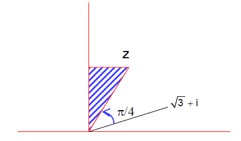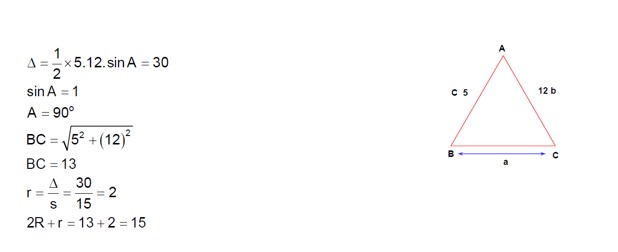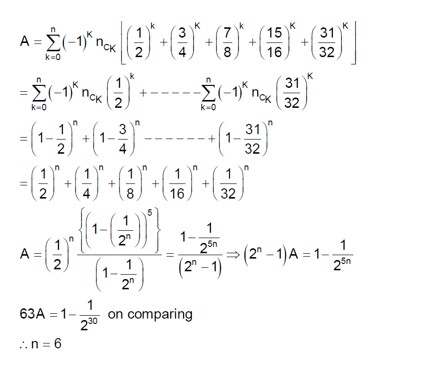Class 11th
Get insights from 8k questions on Class 11th, answered by students, alumni, and experts. You may also ask and answer any question you like about Class 11th
Follow Ask QuestionQuestions
Discussions
Active Users
Followers
New answer posted
2 months agoContributor-Level 10
y = √ (2cos²α / (sinα cosα) + 1/sin²α)
y = √ (2cotα + cosec²α)
y = √ (2cotα + 1 + cot²α) = √ (1 + cotα)²) = |1 + cotα|.
Given α is in a range where 1+cotα is negative, y = -1 - cotα.
dy/dα = - (-cosec²α) = cosec²α.
At α = 5π/6, dy/dα = cosec² (5π/6) = (1/sin (5π/6)² = (1/ (1/2)² = 2² = 4.
New answer posted
2 months agoContributor-Level 10
Given Re (z-1)/ (2z+i) = 1, where z = x + iy.
(z-1)/ (2z+i) = [ (x-1) + iy] / [2x + I (2y+1)]
To rationalize, multiply the numerator and denominator by the conjugate of the denominator [2x - I (2y+1)].
Numerator = [ (x-1) + iy] * [2x - I (2y+1)] = 2x (x-1) - I (x-1) (2y+1) + i2xy + y (2y+1)
Real part of the numerator = 2x (x-1) + y (2y+1).
Denominator = (2x)² + (2y+1)².
Re (z-1)/ (2z+i) = [2x (x-1) + y (2y+1)] / [ (2x)² + (2y+1)²] = 1.
2x² - 2x + 2y² + y = 4x² + 4y² + 4y + 1.
0 = 2x² + 2y² + 2x + 3y + 1.
So, 2x² + 2y² + 2x + 3y + 1 = 0.
New answer posted
2 months agoContributor-Level 10
. Let the terms in Arithmetic Progression be a – 2d, a – d, a, a + d, a + 2d.
Sum of terms: (a – 2d) + (a – d) + a + (a + d) + (a + 2d) = 5a.
5a = 25 ⇒ a = 5.
Product of terms: (5 – 2d) (5 – d) (5) (5 + d) (5 + 2d) = 2520.
5 (25 – 4d²) (25 – d²) = 2520.
(25 – 4d²) (25 – d²) = 504.
625 – 25d² – 100d² + 4d? = 504.
4d? – 125d² + 121 = 0.
Factoring the equation: (4d² - 121) (d² - 1) = 0.
So, d² = 1 or d² = 121/4.
d = ±1 or d = ±11/2.
If d = ±1, the terms are 3, 4, 5, 6, 7.
If d = ±11/2, the terms are -6, -1/2, 5, 21/2, 16.
The largest term is 5 + 2d = 5 + 2 (11/2) = 5 + 11 = 16.
New answer posted
2 months agoContributor-Level 10
Given 2ae = 6 and 2a/e = 12.
From these, ae = 3 and a/e = 6.
Multiplying the two equations: (ae) (a/e) = 3 * 6 => a² = 18.
We know that b² = a² (1 - e²) = a² - a²e² = 18 - (ae)² = 18 - 3² = 18 - 9 = 9.
The length of the latus rectum (L.R.) is 2b²/a.
L.R. = 2 * 9 / √18 = 18 / (3√2) = 6/√2 = 3√2.
New answer posted
2 months agoContributor-Level 10
1st observation: n? =10, mean x? =2, variance σ? ²=2.
Σx? = n? x? = 20.
σ? ² = (Σx? ² / n? ) - x? ² => 2 = (Σx? ²/10) - 2² => 6 = Σx? ²/10 => Σx? ² = 60.
2nd observation: n? , mean y? =3, variance σ? ²=1. Let n? =n.
Σy? = ny? = 3n.
σ? ² = (Σy? ² / n) - y? ² => 1 = (Σy? ²/n) - 3² => 10 = Σy? ²/n => Σy? ² = 10n.
Combined variance σ² = 17/9. n_total = 10+n.
Combined mean = (Σx? +Σy? )/ (10+n) = (20+3n)/ (10+n).
Combined Σ (squares) = 60+10n.
σ² = (Combined Σsq / n_total) - (Combined mean)²
17/9 = (60+10n)/ (10+n) - [ (20+3n)/ (10+n)]²
Multiply by 9 (10+n)²:
17 (10+n)² = 9 (60+10n) (10+n) - 9 (20+3n)²
17 (100+
New answer posted
2 months agoContributor-Level 10
1/16, a, b are in GP. So, a² = b/16 .
Also, a, b, 1/6 are in AP. So, 2b = a + 1/6.
From the first equation, b = 16a².
Substitute into the second: 2 (16a²) = a + 1/6 => 32a² - a - 1/6 = 0.
192a² - 6a - 1 = 0.
The solution appears to solve a different problem.
New answer posted
2 months agoContributor-Level 10
S? (x) = log? ¹? ²x + log? ¹? ³x + .
This is incorrect; the bases are numbers, not powers of 'a'. Let's assume the bases are 1/2, 1/3, 1/6, 1/11, .
The series is S' = 2, 3, 6, 11, 18, .
The differences are 1, 3, 5, 7, . which is an AP.
The n-th term t? is a quadratic in n.
t? = An² + Bn + C.
t? =A+B+C=2
t? =4A+2B+C=3
t? =9A+3B+C=6
Solving these, we get 3A+B=1 and 5A+B=3, which gives 2A=2, A=1. Then B=-2, C=3.
t? = n² - 2n + 3 = (n-1)² + 2.
The solution confirms this finding t? = 2 + (n-1)².
Taking an Exam? Selecting a College?
Get authentic answers from experts, students and alumni that you won't find anywhere else
Sign Up on ShikshaOn Shiksha, get access to
- 65k Colleges
- 1.2k Exams
- 679k Reviews
- 1800k Answers




